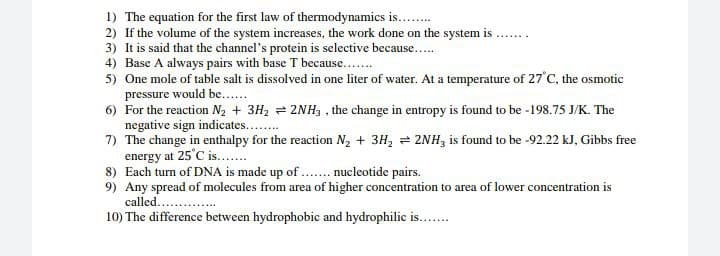1) The equation for the first law of thermodynamics is...... 2) If the volume of the system increases, the work done on the system is 3) It is said that the channel's protein is selective because.....
1) The equation for the first law of thermodynamics is...... 2) If the volume of the system increases, the work done on the system is 3) It is said that the channel's protein is selective because.....
Physical Chemistry
2nd Edition
ISBN:9781133958437
Author:Ball, David W. (david Warren), BAER, Tomas
Publisher:Ball, David W. (david Warren), BAER, Tomas
Chapter4: Gibbs Energy And Chemical Potential
Section: Chapter Questions
Problem 4.14E: Thermodynamic properties can also be determined for ions. Determine H,S,andG for the following two...
Related questions
Question

Transcribed Image Text:1) The equation for the first law of thermodynamics is........
2) If the volume of the system increases, the work done on the system is .
3) It is said that the channel's protein is selective because.....
4) Base A always pairs with base T because.......
5) One mole of table salt is dissolved in one liter of water. At a temperature of 27°C, the osmotic
pressure would be......
6) For the reaction N₂ + 3H₂2NH3, the change in entropy is found to be -198.75 J/K. The
negative sign indicates........
7) The change in enthalpy for the reaction N₂ + 3H₂ = 2NH3 is found to be -92.22 kJ, Gibbs free
energy at 25°C is.......
8)
Each turn of DNA is made up of ....... nucleotide pairs.
9) Any spread of molecules from area of higher concentration to area of lower concentration is
called......
10) The difference between hydrophobic and hydrophilic is........
Expert Solution
This question has been solved!
Explore an expertly crafted, step-by-step solution for a thorough understanding of key concepts.
Step by step
Solved in 2 steps with 2 images

Knowledge Booster
Learn more about
Need a deep-dive on the concept behind this application? Look no further. Learn more about this topic, chemistry and related others by exploring similar questions and additional content below.Recommended textbooks for you

Physical Chemistry
Chemistry
ISBN:
9781133958437
Author:
Ball, David W. (david Warren), BAER, Tomas
Publisher:
Wadsworth Cengage Learning,

Principles of Modern Chemistry
Chemistry
ISBN:
9781305079113
Author:
David W. Oxtoby, H. Pat Gillis, Laurie J. Butler
Publisher:
Cengage Learning

Physical Chemistry
Chemistry
ISBN:
9781133958437
Author:
Ball, David W. (david Warren), BAER, Tomas
Publisher:
Wadsworth Cengage Learning,

Principles of Modern Chemistry
Chemistry
ISBN:
9781305079113
Author:
David W. Oxtoby, H. Pat Gillis, Laurie J. Butler
Publisher:
Cengage Learning